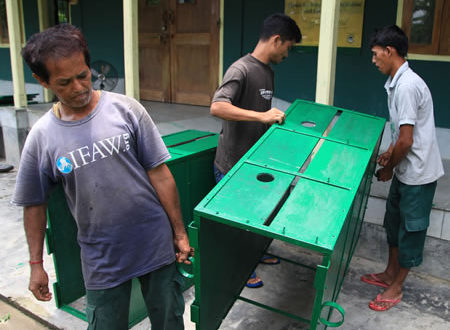CWRC team prepares for floods in Kaziranga
Kaziranga, July 5, 2013: Floods in Kaziranga National Park are an annual occurrence, which claim the lives of many animals every single year. The IFAW-WTI-run Centre for Wildlife Rehabilitation and Conservation (CWRC), in the vicinity, has been assisting the Forest Department for many years in rescuing animals from various parts of the park and rehabilitating them back to the wild whenever possible.
While a few lower areas of the park flooded a week ago, forcing the animals to cross over to higher ground, currently the water level has stabilised and even decreased in some regions. The team at the centre, however, is ready in anticipation of the impending floods with a plan of action, made to assist the Kaziranga authorities.

CWRC’s keepers prepare the animal cages before the imminent flood in Kaziranga. Photo credit: Subhamoy Bhattacharjee/IFAW-WTI
Keeping in mind, rescue missions of previous years, the team has fabricated multiple rescue cages for mammals, reptiles and birds, which include five cages, made especially for deer. The Mobile Veterinary Service (MVS) unit at the centre has also been put at the stand by 24×7 to handle any rescue emergency which may come its way.
“We have been rescuing wildlife in Kaziranga since 2002 and like every year, the team at CWRC is on call at all hours of every day to deal with any incident. We shall also be enlisting the help of our other MVS units in other parts of the state when necessary,” commented Dr Rathin Barman, Deputy Director of WTI.
Kaziranga National Park has more than 200 species of common as well as rare and threatened wildlife species including the greater one-horned rhinoceros, the Asiatic black bear, hog badger, hoolock gibbon, the Asian elephant and the Royal Bengal tiger, among others.

File photo. Kaziranga National Park has more than 200 species of wildlife that are affected by the annual flood. Photo credit: Rathin Barman/IFAW-WTI
“With endangered species such as greater one-horned rhinoceros, elephants, eastern swamp deer, among the animals affected by the flood the necessity for prompt successful rescue and rehabilitation drastically increases at this time of the year. Last year during the floods we rescued 129 mammals, birds and reptiles, which included a lot of hog deer, some swamp deer and two Asian elephant calves, and eventually conducted surveys on the flood affected animals in the park,” added Barman.
Efforts are also being made by the IFAW-WTI team, along with the Assam Forest Department and other local NGOs, to make people aware about the rescue protocols for the wildlife which may get displaced during the floods, in a bid to bring down the casualties this year. Leaflets with relevant information have been prepared in the local languages and distributed to the villages in Kaziranga.
“Important phone numbers including that of the Assam Forest Department Directorate Control Room in Kaziranga National Park and CWRC have been included in the leaflets, along with different pictures of animal rescue protocols. We hope that the reach of this information is even greater this year and we can save the lives of as many species as possible with the vital help of the local people,” said Dr Bhaskar Choudhury, Regional Head (North-East), IFAW-WTI.

Last year during the floods we rescued 129 mammals, birds and reptiles, which included a lot of hog deer, some swamp deer and two Asian elephant calves. Photo credit: Subhamoy Bhattacharjee/IFAW-WTI
“Every year the locals of the fringe villages give their all in trying to rescue distressed wildlife, even while their own homes may be submerged. Such dedication and passion in protecting the natural heritage of the park is extremely touching and extraordinary,” added Choudhury, remembering past floods and the inevitable involvement of the local villages in flood relief.









